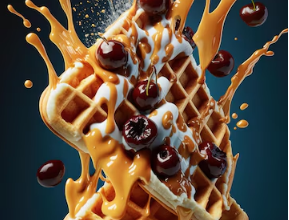The Role of Food Packaging in Modern Sustainability
The Role of Food Packaging in Modern Sustainability

In a world increasingly focused on sustainability, the role of food packaging cannot be ignored. Whether we realize it or not, packaging influences everything from the freshness of the food we consume to the environmental footprint we leave behind. As a packaging company, Print Pack Expert understands the responsibility of creating solutions that meet both functional and ecological demands. Today, food packaging is not just about preserving food; it is a vital part of the global effort to reduce waste and promote sustainable practices.
In this blog, we will explore how food packaging contributes to sustainability, discuss the importance of choosing the right materials, and highlight the innovations transforming the industry.
Why Sustainability in Food Packaging Matters
The Environmental Impact of Traditional Packaging
For decades, traditional packaging materials like plastic and styrofoam dominated the food industry. While these materials served their purpose—keeping food fresh and protecting it during transportation—they also contributed to a significant environmental issue. Single-use plastics, in particular, have become a global problem. They take hundreds of years to decompose, often ending up in oceans, rivers, and landfills, where they harm wildlife and pollute ecosystems.
Every year, millions of tons of plastic packaging are discarded, which makes finding sustainable alternatives essential. The modern consumer increasingly values eco-conscious products, and companies prioritizing sustainability gain a competitive edge. This shift is not just a trend; it’s a necessary step toward protecting our planet for future generations.
Rising Demand for Sustainable Solutions
As awareness of environmental challenges grows, so does the demand for sustainable food packaging. Consumers are not just looking for products that taste good; they want to ensure their purchases align with their values. Studies show that more than 60% of consumers are willing to pay more for sustainable packaging. This shift in consumer behavior is pushing companies to rethink their packaging choices, and many businesses have started to adopt greener alternatives. But sustainability in food packaging is about more than just the materials used; it’s about the overall impact on the environment, from production to disposal.
Key Elements of Sustainable Food Packaging
Biodegradable and Compostable Materials
One of the most significant advancements in sustainable food packaging is using biodegradable and compostable materials. These materials break down naturally over time, reducing the burden on landfills and lessening environmental impact. Custom packaging, in particular, is beneficial because it can be returned to the earth, improving soil health without leaving harmful residues.
Materials like PLA (polylactic acid), derived from renewable resources like corn starch, and molded fiber packaging from plant fibers, are excellent examples of this. These alternatives serve as viable options to traditional plastics, helping businesses reduce their environmental footprint.
Recyclable Packaging
Recycling remains one of the most effective ways to reduce waste and conserve natural resources. Packaging that can be recycled helps close the loop in the lifecycle of materials, ensuring that they can be reused rather than discarded. Materials such as paper, glass, aluminum, and certain types of plastic are commonly recyclable.
However, the challenge lies in ensuring that packaging is designed for recyclability. Multi-layered plastics, for example, can complicate the recycling process, so companies must consider this during the design phase. At Print Pack Expert, we strive to create packaging solutions that are both functional and recyclable, allowing consumers to make eco-friendly choices effortlessly.
Minimalist Packaging
Another approach to sustainability is reducing the amount of packaging used in the first place. Over-packaging contributes to unnecessary waste, and consumers are becoming increasingly frustrated with excessive packaging. Minimalist packaging focuses on using only what is needed to protect the product while reducing material consumption.
Brands that adopt minimalist packaging solutions often see cost savings and a positive response from environmentally conscious customers. Furthermore, minimal packaging can help reduce transportation costs by minimizing the weight and volume of products being shipped, which in turn reduces the carbon footprint of distribution.
Innovations Driving Sustainable Packaging
Edible Packaging
One of the most exciting developments in food packaging is the concept of edible packaging. Made from natural ingredients like seaweed, rice, or potato starch, edible packaging dissolves in water or can be consumed along with the food. This innovation could drastically reduce the amount of waste generated by food packaging.
Though edible packaging is still in its early stages, it holds tremendous potential for industries like takeout and fast food, where packaging waste is a significant concern. Brands looking to stand out as pioneers in sustainability could greatly benefit from investing in this groundbreaking technology.
Smart Packaging
Smart packaging is another innovative solution that enhances sustainability. Smart packaging incorporates technology that can monitor the freshness of food, extend shelf life, and reduce food waste. For example, packaging with embedded sensors can alert consumers when food is about to expire, allowing them to use it before it spoils. By reducing food waste, smart packaging contributes to a more sustainable food system overall.
Moreover, smart packaging can include QR codes or apps that provide detailed recycling Plant-Based Packaging
Plant-based packaging materials are becoming more popular as consumers and companies alike seek alternatives to fossil fuel-based plastics. Materials such as bagasse (a byproduct of sugarcane) or bamboo offer renewable, sustainable alternatives to traditional packaging. These materials are both biodegradable and compostable, helping to reduce the reliance on plastic while providing sturdy, practical packaging solutions.
Plant-based plastics (bioplastics) are also being developed, which behave like traditional plastic but break down more quickly and with less environmental impact.
Challenges in Implementing Sustainable Packaging
While the advantages of sustainable food packaging are clear, there are still challenges to overcome. First, there is the issue of cost. Eco-friendly materials and technologies tend to be more expensive than their traditional counterparts, which can make them inaccessible for smaller businesses. However, as demand for these materials increases, we can expect prices to drop over time.
Another challenge is the lack of infrastructure for recycling and composting. In many areas, compostable materials cannot be properly processed due to insufficient facilities, meaning these items may end up in landfills anyway. This highlights the need for a holistic approach to sustainability, where packaging design, consumer behavior, and waste management systems work together.
The Future of Sustainable Food Packaging
Looking ahead, the future of food packaging will likely continue to evolve toward greater sustainability. Innovations like edible and smart packaging show that we are only scratching the surface of what’s possible. Businesses that invest in research and development now will be at the forefront of this change, positioning themselves as leaders in sustainability.
Consumers will also continue to play a crucial role. As they demand more eco-friendly products and take steps to reduce their own environmental footprints, the food packaging industry will have no choice but to keep pace.
How Print Pack Expert is Leading the Way
At Print Pack Expert, we are committed to advancing sustainability in food packaging. Our team continually researches and implements new technologies and materials that meet the highest standards of environmental responsibility. Whether it’s designing recyclable packaging or exploring plant-based options, we ensure that our solutions not only protect food but also the planet.
We believe that every business has a role to play in creating a more sustainable future, and we are proud to offer packaging solutions that help companies meet their eco-friendly goals.
Conclusion:
Sustainable food packaging is not just a trend; it’s a necessity. Businesses can make a real impact by choosing eco-friendly materials, embracing innovative technologies, and minimizing waste. As we move toward a greener future, food packaging will continue to play a critical role in modern sustainability.
If you are also interested, in Kraft and Cardboard we highly recommend visiting this link for more information and opportunities:
How Custom Bakery Boxes are Created Using Kraft and Cardboard

